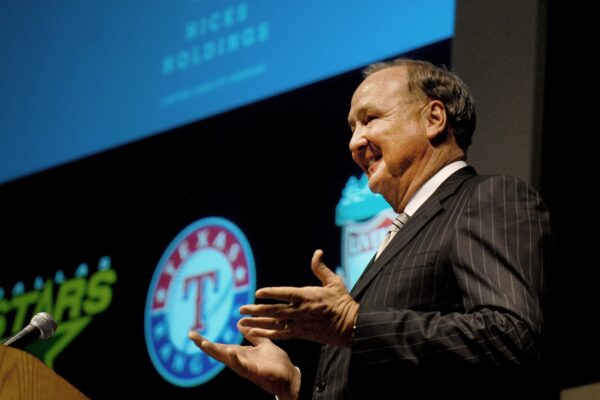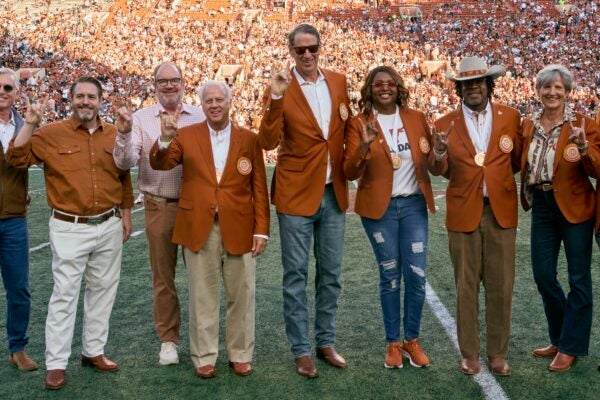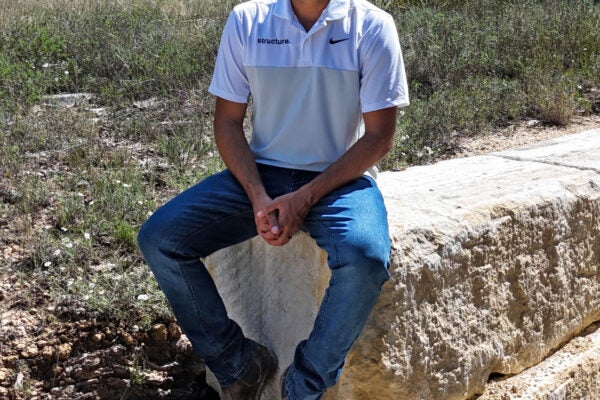An Interview with Venture Capitalist Bill Gurley, MBA ’93
On entrepreneurs, high-tech startups, and launching a Silicon Valley career

By Fred Vogelstein
Photographs by Timothy Archibald
ASK FOR A LIST OF THE TOP venture capitalists in high-tech, and Bill Gurley’s name comes up quickly. Most of the world had barely heard of Silicon Valley when he earned his Texas MBA in 1993.
Today, as the backer of marquee-name companies like Uber, Twitter, OpenTable, Yelp, Zillow, Dropbox, Instagram, and Snapchat, Gurley and his firm Benchmark Capital have helped make Silicon Valley arguably the hottest place to start a business career.
Conventional wisdom among venture capitalists today says bigger is better. Yet Benchmark, where Gurley has been a partner since 1999, is unique among the top VC firms: egalitarian and small. There are only six partners, and all of them share in the firm’s profits equally. They limit each investment pool to a maximum of $500 million. And they hesitate to invest in any venture that is not within driving distance: Gurley says body language from a spur-of-the-moment coffee with an entrepreneur reveals a lot more about what’s going on at a company than a Skype call or even a two-day sweep through a city. The strategy has worked astonishingly well. Benchmark’s $12 million investment in Uber in 2011 alone has become one of the best investments in Silicon Valley history. When the ride-sharing company raised money last year, investors valued it at $62.5 billion.
In the past year, however, Gurley has become the scold of Silicon Valley. He takes any opportunity he gets to make the case that high-tech is in the midst of an unsustainable bubble that is months from popping. Venture money is flowing too freely, valuations for early-stage companies are stupidly high, and the quality of entrepreneurs he sees is falling.

VCs don’t typically talk like this — at least publicly. Most would rather stand accused of being too optimistic than going cautionary like Gurley has. But few dismiss his views, either. He’s been on the front lines of high-tech investing for 23 years, and he’s been part of the inflation and deflation of two tech bubbles — the big one in 2000 and the smaller one in 2008. After McCombs, he spent three years on Wall Street as a financial analyst covering the PC industry. He moved to Silicon Valley in 1996 to become the lead analyst for top investment banker Frank Quattrone. There, at Deutsche Bank, he worked on the IPO for Amazon.com, among other deals, before joining venture firm Hummer Winblad in 1998 and Benchmark 18 months later. When the big Internet bubble popped in 2000, Benchmark got hit hard. As you’ll see from my conversation with him, the sense of déjà vu is overpowering.
Q: How did you end up attending McCombs, and what took you from there to Silicon Valley?
A: I grew up in Houston. My father was in the space program. He worked at NASA from the very beginning. Half the fathers on my street worked at NASA. I’m 49, so I’m old enough to remember talk about the Apollo program all over my house. My older sister went to Rice [University] as a double-E [electrical engineering] major and was employee 63 at Compaq. So that also played a role in my interest in tech. She got options. Compaq went public. So I was seeing this stuff that I wouldn’t have seen otherwise.
After graduating from the University of Florida, I interviewed at IBM and Compaq. Compaq was offering way more money, so I moved back to Houston. And then Borland went public, and I bought the stock. I’d used its products Quattro and Turbo Pascal in college and at Compaq. I started trading stocks. That led me to more curiosity about business and finance. It was fascinating. I had gone from, “Okay, I like computers,” “I like comp-sci,” and “I like engineering” to watching Compaq and Borland go public and wondering, “How does this Wall Street thing work?”
I applied to a bunch of business schools. I got into Michigan and Texas. I went to Texas because I decided to stay closer to home and had always wanted to attend the university. I came into my MBA with a burning desire to get something out of it. I think one element of being successful at business school is making sure you aren’t doing it because you just think it’s the next thing you’re supposed to do. Because by the time you go you’re 25 or 26 — you’re not a young whippersnapper. This is a voluntary decision. So you have to ask yourself, “Are you going to roll around in it?” And I wanted every single thing I could get out of it. It was probably the first time in my life I became a voracious reader. And I’m not talking about just the textbooks, but business publications like Fortune and the Wall Street Journal and BusinessWeek and books — every book I could get my hands on. I just had a blast.
Q: After getting your MBA you went to Wall Street?
A: I toyed with the idea of getting into venture. But I met with some AV [Austin Ventures] guys and knocked on doors. Just complete cold call, you know? I wound up at CSFB [Credit Suisse First Boston]. A guy named Al Jackson hired me and took a bet. They trained using trial by fire. They would just give a freshly graduated MBA student a category and say, “You’re an analyst.” If you go anywhere else, you’re a junior analyst for a while. At CSFB a year and a half in, I made the II [institutional investor] ranking.
Q: That’s big.
A: Then the top three analysts covering the PC industry retired: Dan Benton, David Korus, and Charlie Wolf, who was at CSFB. Charlie became the advisor for young analysts, so I got to work with him. Dan and David became friends, so they both gave me all their [financial] models. So it’s like they all got out of the way. There was a ridiculous amount of serendipity.
Q: For how long were you at CSFB?
A: I was there for three years, and that’s when Above the Crowd [Gurley’s newsletter] launched, which is actually a knockoff of something Korus was doing. He did a weekly fax. People loved him for it. When he retired, that stopped. So I copied it. Back then the prevailing view was that research like Above the Crowd should only be given to a firm’s clients. But the economic incentive for analysts was to become well known. So I started giving away everything. That got me exposed to all the executives in the PC industry. One of the things that helped propel me into venture was that I got invited to the Agenda Conference, [writer and VC] Stewart Alsop’s conference. It was everything back then.
Q: I remember that.
A: There was a Palm Pilot for sale. And I bought it at the event. It had every attendee’s contact information. So I spammed the entire Agenda without their permission. Then Frank Quattrone [the investment banker] called me out of the blue and said, “We’re leaving Morgan Stanley, we’ve heard a lot of things about you, we want you to join us.” Frank and I had a long talk, and he said, “What do you want to be long term?” I said, “I’d love to be a VC.” He said, “Come to work for me, I’ll move you to Silicon Valley and introduce you to every venture capitalist that I know.”
So that’s how I got here. He did exactly what he said he’d do.
Q: Talk about the current economic climate in Silicon Valley. What led you to conclude we are in a bubble? Why are you worried about that?
A: I believe that in a world where capital is super easy to raise, it’s a net negative for great entrepreneurs. So if we’re in the business of backing the best entrepreneurs and helping them build long-standing, sustainable companies, this is a horrible environment for that.
A good entrepreneur is systematically advantaged in an environment where it’s tough to raise capital. I would go as far as to say that you could have 60 years of business experience. You could be Jack Welch. You could be Warren Buffett. You could be [Jeff] Bezos. And it doesn’t prepare you for a world where your less talented competitor can afford to lose $300 million next year and maybe the same the year after because of all the money they’ve raised. There’s no rule book for that world.
Q: Were there a couple of events or deals that made you say, “We’re there?”
A: Well, the first thing that started happening — a huge contrast to ’99 — is that there are fewer companies being funded than in ’99. But they’re being given remarkable benefit of the doubt, and they’re allowed to raise amounts of capital that are unprecedented. I’d have to look, but I’d bet 20 of our companies have raised over $100 million. And the burn rates are way higher now than in ’99. Way higher.
Q: That’s backwards, isn’t it? I thought it was more expensive to start a company back then. I thought that more venture money was raised then compared to now. Back then you needed office space and expensive software, servers, and bandwidth to start a company. Now all you need is a credit card, a laptop, and an Amazon web services account to start a mobile app company.
A: That whole notion gets way too much airplay — that you can start a company for nothing. Here’s why: People are more expensive than they’ve ever been. If you’re going to hire people, it’s expensive to build a company. There are engineers coming out of MIT making $175K. If you’re going to hire 30 people, it’s expensive.
Q: That’s a lot more than a Sun server.
A: Exactly. There’s no super cheap company out there. The press is obsessed with that notion, and it’s not realistic.
Q: Have there been a couple of deals that drove your thinking?
A: When I start seeing things that are overly promotional and fall into the realm of entrepreneur-as-snake-oil-salesman, I always get concerned because I know that’s unsustainable. It’s also bad for Silicon Valley’s image. Silicon Valley looks the worst when we start acting entitled. You know, “We get to eat the world. We get to disrupt everything. But guess what? We don’t actually want to be profitable. We don’t want to be held to your rules. We don’t want to be accountable. We don’t want to have to go public.” That’s pretty entitled thinking. We look like babies.
So you asked for specific examples. I can remember being at a conference where the Fab CEO was on stage. Someone asks, “What’s your sustainable competitive advantage?” And he says, “Oh, my co-founder is the best designer on the planet.” I thought to myself, “You know, based on everything I’ve read about business, starting back to my Texas days and studying, that doesn’t add up.” It was like this doesn’t make sense. It eventually became true and didn’t make sense. [Fab raised $330 million to create an Adobe Flash-based e-commerce site for small design shops to sell their wares. It was valued at nearly $1 billion by summer 2013. Fifteen months later it was effectively dead.]
Some of the work the Wall Street Journal has done on Zenefits is also worth looking at. I think the CEO was quoted as saying, “We’re going to be $100 billion in revenue.” What is going through your mind to say that? I think they ended up doing $35 or $40 million in revenues last year. So even $1 billion, 1/100th of that is plenty aspirational. [Zenefits just replaced its CEO.] When I see that stuff, I feel like we’ve trained entrepreneurs to value the wrong things, to just be promoters.
Today, as the backer of marquee-name companies like Uber, Twitter, OpenTable, Yelp, Zillow, Dropbox, Instagram, and Snapchat, Gurley and his firm Benchmark Capital have helped make Silicon Valley arguably the hottest place to start a business career.
Q: There’s a certain amount of promotion that’s required to be an entrepreneur though.
A: No question. I have a graph that has promotion skills on one line and execution skills on the other. The Bezoses know how to do both. But very few others do.
Q: Benchmark has had unparalleled success. Do you have a model or a vision of the world that you use to evaluate companies you see?
A: We have this partnership model where all the partners share equally in the profits. Things don’t scale well inside of that because we don’t have a CEO. We experimented with expansion coming out of ’99. We launched Benchmark Europe and Benchmark Israel and tried to replicate what we do, recognizing that entrepreneurism wasn’t a U.S.-centric thing. And it caused all kinds of distraction. We had done a billion dollar fund in ’99. So we told our limited partners in 2007, “We’re going to $400-million funds. We’re only going to do early stage. We’re not going to do international. We’re not going to do growth. We’re not going to do seed.” I think it was very fortuitous timing because almost three or four years after we did that, all of our competition started scaling out in huge ways into different geographic sectors. They became stage agnostic. They raised huge, billion dollar funds. And, to me, that’s been the seminal event that led to our success — that we chose to focus. And being focused as an investor I think is the most important thing. It means giving up the notion that you’re going to scale up and take over the world. But I don’t believe that there are network effects to venture.
Q: Be more specific. What led you toward Twitter? What led you toward Uber? You’re not taking a dartboard approach. What’s the frame you use to evaluate companies?
A: When we failed to pursue Google in 2002, I remember a lot of the reasons we didn’t chase it were rule-of-thumb things that we all had assumed were true about venture. Things like: “You can’t have two Ph.D.s running it,” “Search is a mature business,” “Yahoo has just gone from $82 a share to $10,” “Excite got sold for nothing, or went bankrupt.” I learned that if you use rules of thumb, you can actually get yourself in trouble.
So we have an evolving rule set, which is a really amorphous thing. It works well to have a group of smart people juxtaposing and guessing together and challenging each other’s assertions. Because the rules change.
One of the things that’s really important about venture is you have to conceptualize ideas that have lots of running room, and where the incumbents aren’t going to play.
Anytime something gets overly choreographed — like virtual reality or self-driving cars right now — it’s probably not going to be a great venture category. Everyone’s talking about them 10 years before they are going to break out. That’s where all the incumbents go. The stuff that comes out of nowhere — where no one was thinking it was possible — those are the grand slams that go out of the park.
Q: How do you prepare yourself for stuff that comes out of nowhere?
A: It’s a hard question. Where we really screw up is when we decide “no” for the wrong reason.
If we bet $10 million on a company that doesn’t work, we lose $10 million. When we failed to put $12 million in Google, and the deal went to Kleiner and Sequoia, we missed out on a thousand times that. The real question is, “Are you getting enough at-bats?”

If you’re getting the at-bats and you bat .400, you’re very successful in venture. But if you’re not at bat at all, then your odds of hitting a home run with one at-bat is low.
Q: When I wrote my book about Apple and Google, one of the questions I got from a lot of people is how do we re-create the kind of energy that exists in Silicon Valley elsewhere? I know people have been asking that question for years, but what’s your answer? Is having all the companies you invest in be driving distance away part of the answer?
A: Yes. I can grab coffee with the VP of marketing at one of our companies tomorrow. I can’t do that if it’s a plane flight away.
Q: But you can Skype. What’s the difference?
A: The difference is immense. Like, your ability to persuade someone if you have face-to- face time is so much higher. There are also all these other ephemeral things that make Silicon Valley different. It’s remarkably open in a way that probably would be super hard to explain to other people elsewhere. You can cold call someone here who’s fairly high up and say, “Man, I’m really impressed by what you’ve done. Can I get 30 minutes or an hour for coffee? I want to ask you some questions.” I’ve found 80 percent of the time they say “yes.” The knowledge sharing that can come from that is unique.
“I believe that in a world where capital is super easy to raise, it’s a net negative for great entrepreneurs. So if we’re in the business of backing the best entrepreneurs and helping them build long-standing, sustainable companies, this is a horrible environment for that.”
Q: How are Silicon Valley and the VC business different today than they were 15 years ago?
A: Venture has gotten much more competitive.
Q: Even more than it was in 1999 and 2000?
A: In seed and late stage, there’s hyper competition. What I think that has caused, unfortunately, is that most VCs live in fear of a bad reference.
Q: From whom?
A: From entrepreneurs. I think Silicon Valley boards are probably the softest they’ve ever been. If you go back to the old days of venture capital, you hear stories about the Don Valentines of the world just iron fisting their way through a board meeting. [Valentine founded Sequoia Capital in 1972 and was one of the early investors in Apple, Atari, Oracle, Cisco, Electronic Arts, Google, and YouTube.] No one does that today, and it makes the job of a VC a lot tougher. In a board meeting you can’t influence through fiat or contracts. You have to do it all through persuasion.
Q: Talk about the Valley bro culture. How do you tell women and minorities that Silicon Valley will be just as welcoming to them?
A: I have a strong reaction to that. There’s bias that’s intentional bias, and then there’s bias that comes from systematic exposure to something that causes me or someone to behave in a way that might be biased. I have never seen anyone in Silicon Valley talking in a racist or gender-biased way for the sake of it. And there are certain nationalities — India, China — that are well-represented in Silicon Valley. Probably overrepresented relative to the U.S. footprint. And I think if you look at African Americans, or if you look at females, they’re underrepresented. But I would heavily discourage the notion that someone shouldn’t come here because of that. I don’t think there’s this intentional bias out there. Everyone is very opportunity-driven.
I’d also say that we have to work equally hard at celebrating the successes as we do pointing at the problems. In other words, there are some remarkable female VCs, you know, Mary Meeker [Kleiner Perkins] and Ruby Lu [DCM Ventures] and Jenny Lee [GGV Capital], and Rebecca Lynn [Canvas Ventures]. You need to make it look possible. And it is possible. By the way, it’s way better on the entrepreneur side than on the VC side. We have numerous portfolio companies with female founders, female CEOs who are phenomenal. Katrina Lake, the 31-year-old CEO of Stitch Fix, is one of the best entrepreneurs I’ve ever worked with. Without a gender qualifier. Just flat out.
Q: If you had to do it all over again, would you do it any different?
A: That’s a great question. I get asked that in every interview I do. I probably would have come straight to Benchmark, and I certainly would have tried to invest in Google. The second one would be the №1.
Q:Anything that’s not really obvious?
A: No, look, I pinch myself. I love the venture game. I love entrepreneurism, I love technology, I love betting, I love investing. If there were an epitaph to my career, I would love for it to be, “He loved the job more than anyone else.”
From the spring 2016 issue of McCOMBS, the magazine for alumni and friends of the McCombs School of Business.
Fred Vogelstein is a contributing editor at Wired magazine in San Francisco. He is the author of Dogfight: How Apple and Google Went to War and Started a Revolution. He lives in Berkeley and has covered Silicon Valley for 15 years.
About this Post
Share:


